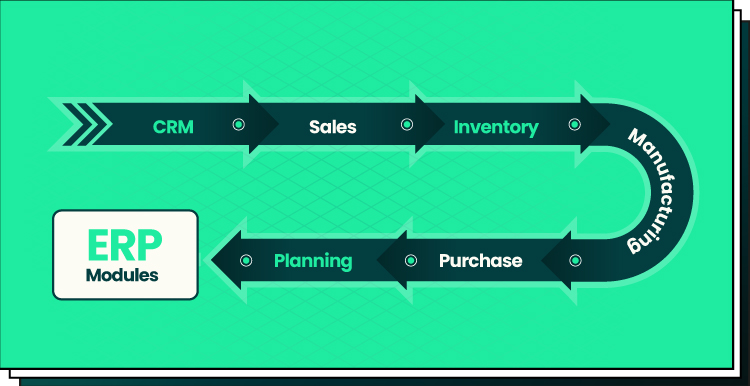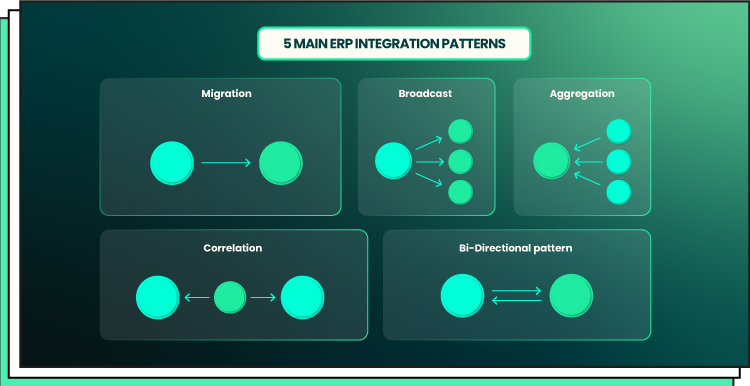Even the biggest companies face challenges in today’s fast-paced business world. With manual operations and a lack of centralization and connection between departments, they often struggle with fragmented data systems, inefficient processes, and weak scaling.
Some businesses select specialized software for different business functions such as CRM, HR, or finance and integrate them with other systems. Other companies build custom software solutions in case they cannot find the off-the-shelf apps to meet all their requirements. But implementing these solutions requires much time and effort.
Still, for those aiming to centralize their management effort, there exists a good tech solution: ERP integration. ERP connects different systems and helps companies boost efficiency, agility, and growth. However, ERP system integration is also challenging, requiring specialized expertise and relevant resources.
Luckily, you’ve come to the right place. In this article, the Forbytes team will talk about ERP integration and show how to use it with maximum benefit for your business. Keep reading this post to integrate ERP securely and effectively.
What Is ERP Integration and When May You Need It?
Enterprise resource planning (ERP) software is a solution for internal data management. In 2022, the ERP market share was valued at $55 billion, projected to result in a market volume of $62,36 billion by 2028 with an annual growth rate of 4,48%.
With the help of ERP system integration, businesses keep track of end-to-end data flow and efficiently manage internal processes. The data stored and managed with ERP software can include a client, partner, supplier, product, finance, and other types of data.
Using this all-in-one solution, retail businesses enable effective data management across departments. Data is synchronized in one centralized system, giving retailers better visibility of the current state of resources and processes.
Now, let’s move to ERP system integration. As we’ve said above, ERP integration is the process of implementing an ERP system into other systems or connecting it with other solutions. Such integration can involve any software that your e-commerce or retail business uses. Here are the solutions you can use to integrate e-commerce with ERP:
- Front-end e-commerce solutions (like an e-commerce site or/and application);
- CRM (Customer Relationship Management) system;
- OMS (Order Management System);
- PIM (Product Information Management) System;
- EDI (Electronic Data Interchange), etc.
Integrated ERP systems are the first steps to an effective business intelligence strategy. They allow you to keep your data in sync and connect all your data points. Here is what you can get with ERP being integrated into your e-commerce system:

When Do You Need the ERP System Integration?
EPR system integration can be the way to successful omnichannel commerce. If all crucial data points are siloed, your employees lack a consistent understanding of the supply chain flow. Do you want to achieve maximum accuracy in your business processes and operations? Then you will need to build an effective resource planning system.
Check these 5 signs to understand if it’s the right decision to invest your money in an integrated ERP system:
1. There’s a lot of manual work
To automate business processes and improve your workflow, you need an integrated ERP system. Suppose that you have a potential customer who subscribed to your newsletter and added some products to the shopping cart on your e-commerce shop. If your CRM is integrated with an ERP system, the customer data will automatically be transmitted to the system.
Your employees will evaluate the lead, analyze their behavior on your site, and leverage this data when making supply-demand predictions. Marketers can use analytics and reporting features of ERP software to facilitate the lead journey. It can help your team turn site visitors into return clients.
What if your ERP system is not integrated with your CRM systems? Then, your employees will have to manually enter the data on this lead into an e-commerce dashboard. They may forget to do this, enter the wrong data, or even lose data on this user. And this will be equal to losing a valuable lead in this case.
2. Your data is siloed
Disintegrated solutions cannot give you a clear understanding of your business as a single entity. Sure, you may ask your team to transfer data manually from system to system. But imagine how much work they will have to do, with no guarantee for you that these data will be transferred securely and precisely.
In a highly competitive environment like e-commerce or retail, clients don’t want to wait for too long. Cross-system data transfer takes time. During this time, you may fail to give enough attention to a lead, and they might go to a competitor. That’s why it is important to integrate e-commerce in ERP.
3. You often deal with errors
Retail businesses often suffer from mistakes and errors because of manual data entry. If you face similar problems, you need to connect integrated ERP systems with other pieces of software.
When humans work with tons of similar data, it’s nearly impossible to avoid errors. For instance, such situations happen when your employee enters the wrong customer ID or the wrong product SKU into the system. The wrong data can have a great impact on your marketing strategy and supply chain management. To minimize the number of dissatisfied customers and get a stable position in the market, consider ERP system integration.
4. Your sales funnels don’t perform well
A sales funnel involves the whole path the user undertakes, from being a lead to turning into a business evangelist. Depending on the stage of the client journey, your team can use different systems and business applications to collect and analyze data.
Neglecting some aspects may lead to ineffective conversion on this sales funnel. ERP system integration can help you solve this problem. Cross-channel data integration will help you enhance the client journey and lead them smoothly from acquisition to completed orders.
5. You lack a tool for effective cross-department cooperation
Your departments may perform well if working separately. At the same time, they lack a system where their efforts can be centralized and unified under one joint goal.
With an integrated ERP system, you can achieve 100% data consistency for all your departments. Whenever they need to analyze the state of your business from a bird’s eye view, the team will know where to refer to. Stock availability, supply management, inventory maintenance, client experience management — all these aspects will be easily managed under one roof.
Key Benefits of ERP Integration
53% of IT decision-makers consider ERP integration as the solution as a top investment priority, along with CRM. But what are other benefits that encourage businesses to consider integration with EPR systems?
- Business automation. According to a Gartner report, 91% of companies are involved in digital initiatives, and 89% have either adopted or intend to adopt a digital-first approach to business. By doing so, they strived to automate and streamline business processes. Integration with ERP systems allows for automated data flow from one system to another. Enterprise resource planning software integrated with other business solutions will help your team forget about keeping manual data records and managing them inefficiently.
- Data accuracy. This benefit is important in time-dependent situations. Suppose that your client canceled the order. Suppose the e-commerce team doesn’t pass this information to the stock management team on time. In that case, the warehouse employees may prepare the order for delivery, spend time and resources on the packaging, and use the wrong order data to plan the restocking process.
- Efficiency. At least 95% of companies reported some improvements in their operations because of ERP systems integrations. With an integrated ERP system, you reduce manual workload and the number of mundane tasks your employees deal with. This, in turn, reduces the chances of an error, which leads to higher operation accuracy and effectiveness. Your team may use the time freed as a result of ERP systems integration for more value-added activities. For example, exploring new niches, improving marketing strategy, facilitating user journeys, etc.
- Streamlined workflow. With centralized data, your team will get a clear view of how one process affects another. ERP systems integration gives your team the space for effective cross-department cooperation. The best practices of one department may be successfully implemented by another department. Such changes will have a positive impact on overall business performance and employee satisfaction.
- A clear vision of your business. By integrating an ERP system, you get the chance to look at your business from a fresh perspective. This can help you find the gaps and bottlenecks that prevent users from making an order or returning to you after the first sale. Regular improvements based on client feedback will lead to higher conversion and happy clients.
How ERP Integration Is Implemented in E-commerce?

Below, we describe the main types of integrated ERP systems businesses need. Contact our team if you seek help with any of these:
eCommerce integration with ERP
If you run an online store using e-commerce platforms like Magento or Shopify, you are likely to store big volumes of front-end data. By the way, you can check the difference between an e-commerce platform and a marketplace in our recent article.
Integration of your ERP with an e-commerce store will provide your internal teams with accurate data on orders, delivery status, client segment, etc. What’s more, your e-commerce store will get real-time data on stock and inventory management that is handled with ERP software.
CRM integration with ERP
To achieve high client retention, you need to make sure that all your departments have access to client data. For example, data on the quality and speed of delivery methods collected by your logistics department may have an impact on the overall client satisfaction rate. For data collection, you will need CRM ERP integration. Forbytes can help you integrate your ERP solution with a CRM system and ensure that all your teams work in sync for the common goal.
Project management integration with ERP
Project management software is used to facilitate cooperation and work within a team. You can integrate project management software with ERP software and get numerous benefits. You will see how task completion affects your business functions and operations. What’s more, your team will use the insights from ERP system integration to prioritize tasks for a team managed in the project management tool.
EDI integration with ERP
An electronic data interchange (EDI) system is used for exchanging business data with external stakeholders. The stakeholders can include partners, suppliers, distributors, and other decision-makers. The data exchanged includes transaction, delivery, supply order, stock level data, etc. But for an EDI system to transfer data across channels, the data should be extracted from one, centralized source. ERP platform can be this source of real-time data for EDI solutions.
EAM integration with ERP
EAM (Enterprise Asset Management) solutions are used by manufacturers to keep track of their assets. The latter can be raw materials, hardware and software, vehicles, and other equipment. Businesses that manufacture products will benefit from EAM system integration with ERP. Using ERP, they will streamline their daily activities and use the data from ERP to optimize manufacturing.
If you need help with integrating ERP with your existing solutions, consider hiring an experienced e-commerce development partner. A professional company can aid you in choosing the right ERP system and customizing it to serve all your needs.
Contact us if you are looking for reliable and effective ERP systems integration services.
Top 5 ERP Systems Integration Methods
The peculiarities of the ERP process depend on the software you use and your business processes. But there are some common patterns for ERP integrations, and they can form the ground for your integration strategy:

- Migration. Under this eCommerce ERP integration method, data from one system is automatically migrated to another system. This reduces the load on the source system and can affect your expenses if you pay for the on-demand third-party services.
- Broadcast. Under the broadcast method, there is a one-way data flow from the main module to multiple systems. The data transfer takes place in real-time – once the main module gets fresh data, it transfers the data to other systems.
- Aggregation. This method works oppositely to the broadcast method. Under aggregation, data from multiple modules is transferred to a single location.
- Correlation. To some extent, the correlation resembles the broadcast pattern. This method allows the datasets to be shared equally between two targeted systems.
- Bi-directional pattern. This pattern enables bi-directional data flow between two or more datasets. It’s leveraged when two systems use the same data type to fulfill different goals.
How to Integrate E-commerce with ERP
- Build an ERP system or find an external ERP vendor that offers secure and client-centered services at a reasonable price.
- Make sure that the vendor provides businesses with all the necessary features that you need.
- When you decide on the ERP software, choose among the ERP integration methods and develop an effective strategy for ERP integration.
- Configure the e-commerce API token that will connect ERP and other systems with each other.
- Set up the data flow algorithm that will determine the rules for the interaction between the two systems.
- Set up the interaction logic for all data pipes and data fields to unify the data exchange process.
- Automate the data flow and configure the frequency of synchronization.
Need Help with Integrating Your Software?
As you see, integrating ERP can bring numerous benefits. If you use multiple business solutions, it’s a must to keep data consistent across all channels and tools.
Forbytes has vast experience in e-commerce solution development and integration. For years, our team helps retailers optimize their processes and keep their data in sync with intuitive and performant enterprise systems.
Contact us if you need prompt help with integrating your ERP software with other systems or building such a solution from scratch.

Our Engineers
Can Help
Are you ready to discover all benefits of running a business in the digital era?

Our Engineers
Can Help
Are you ready to discover all benefits of running a business in the digital era?







